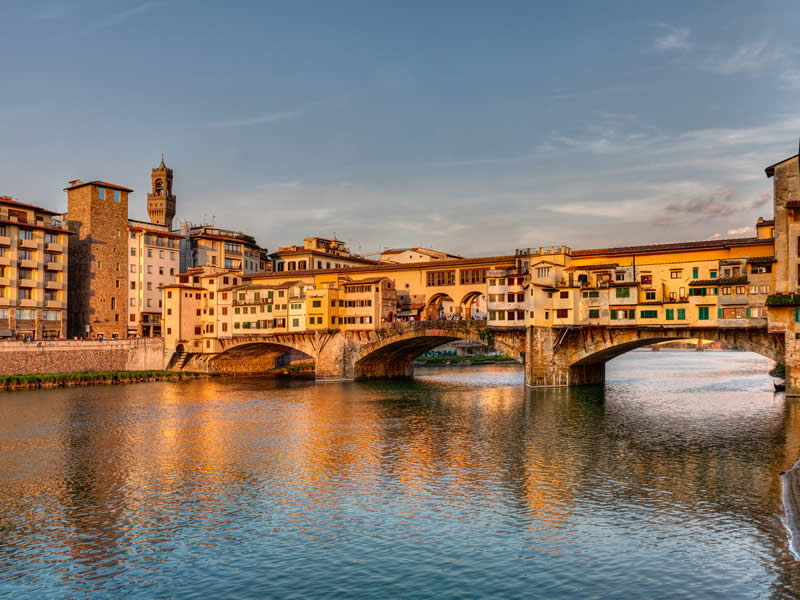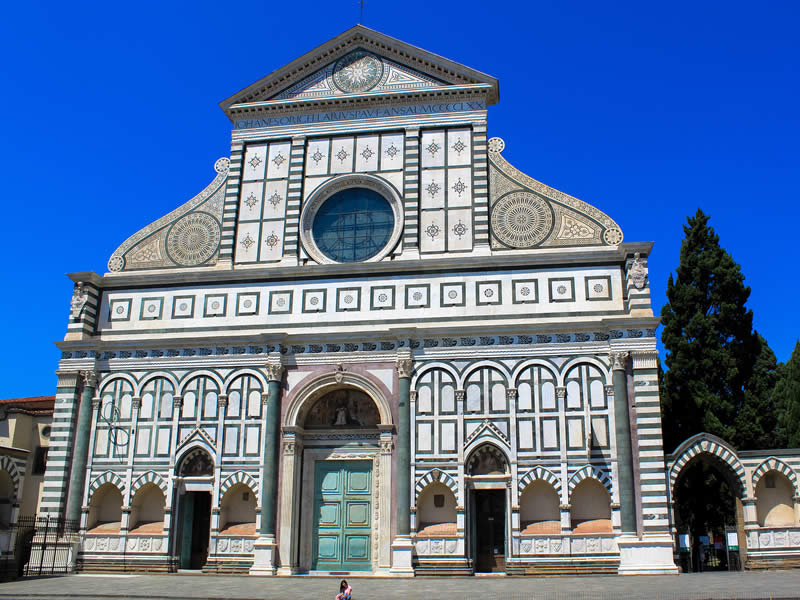The capital city of Tuscany region has nearly 400.000 inhabitants. Known as the capital of Italian Reinassance, it has countless sculptures, piazzas, civic and religious buildings, palaces, markets, and museums which make it a unique destination.
Famous worldwide for its perfect preservation, Florence stands as it did during the fifteenth century. Nevertheless, thanks to the modernization projects commissioned by the city’s town hall, Florence is a perfect mix of modernity and classicism.
Florence’s museums, palaces, and churches are some of the greatest artistic treasures in the world.
The most popular and important sites in Florence include the Cathedral, the Baptistery, the Uffizi, the Bargello, Palazzo Pitti, Ponte Vecchio, Boboli Garden, and the Accademia. The churches of Santa Maria Novella and Santa Croce are veritable art galleries, and the library of San Lorenzo is a magnificent exhibition of Michelangelo’s architectural genius.
Book your stay in Florence, get the best conditions
Some things to visit in Florence

Santa Maria del Fiore
City of artists, Florence offers visitors all kinds of beauties which it is impossible not to fall in love with. First of all Santa Maria del Fiore , also known as the Duomo of Florence . It is a cathedral 153 meters long, built to rival the churches of rival cities Pisa and Siena. Illustrious names of Italian art took part in its creation: Giotto, Brunelleschi, Vasari and Ghiberti, just to name a few. In Piazza del Duomo there are also two other famous Florentine monuments, the Baptistery and the Bell Tower. While the first represents one of the oldest buildings in the city, the Campanile was designed by Giotto and constitutes the bell tower of the Cathedral.

Ponte Vecchio
In the list of what to see in Florence, Ponte Vecchio cannot be missing . A peculiarity of this suggestive place, known today not only for its beauty but also for the goldsmiths' shops, is that until 1565 it was the greengrocers and butchers shops that represented the main attraction of the place. Until 1218 Ponte Vecchio was the only one to cross the Arno in Florence. Above the goldsmiths' shops of Ponte Vecchio you can admire the Vasari Corridor , built by Giorgio Vasari to allow these workers to move from Palazzo Vecchio to Palazzo Pitti in total safety.

Palazzo Vecchio
Piazza della Signoria is home to another of the top 10 things to see in Florence , namely the Palazzo Vecchio . It is the political symbol of the Tuscan capital and rests on the ancient ruins of the Roman theater of Florentia. Built in the form of a castle, it has a characteristic tower 94 meters high which makes it very difficult to be able to photograph the palace in its entirety. One of the most characteristic rooms of Palazzo Vecchio is the Sala dei Cinquecento , which with its 54 meters in length, 22 in width and 17 in height represents the largest room in all of Florence.

Piazza della Signoria
Among the things to see in Florence Piazza della Signoria is inevitable. In addition to Palazzo Vecchio, in fact, this extraordinary city space also houses other wonders inside. In the square you can admire a copy of Michelangelo's "David" , which the sculptor placed in front of Palazzo Vecchio to symbolize the power of the Florentine Republic in contrast to the tyranny of the Medici. Among the other statues in the square are the "Neptune" by Ammannati , the equestrian sculpture of the Duke "Cosimo I" by Giambologna and "Hercules and Cacus" by Bandinelli . To the right of Palazzo Vecchio you can instead be amazed by the beauty of the Loggia dei Lanzi, a small open-air gallery with several works placed inside. Among these the "Rape of the Sabine Women" by Giambologna and the statue of Perseus with the head of Medusa by Benvenuto Cellini.
Galleria degli Uffizi
The Uffizi Gallery is one of the most important Florentine treasures. Its construction dates back to 1560, when Giorgio Vasari designed these spaces as a perspective machine to enhance the Tower of Palazzo Vecchio. Today the Uffizi represent one of the most important museums in the world with its extraordinary collections of ancient sculptures and paintings, ranging from the Middle Ages to the modern age. In addition to fourteenth-century and Renaissance paintings by artists such as Giotto, Piero della Francesca, Botticelli, Leonardo and Michelangelo, the Uffizi Gallery also houses an extraordinary collection of busts and sculptures of the Medici family.

Church of Santa Maria Novella
Another place of worship that cannot be missing from the list of what to see in Florence is the Church of Santa Maria Novella . Architecturally, this building represents one of the most important Gothic-style churches in all of Tuscany. The exterior and facade of the church are the work of Fra Jacopo Talenti and Leon Battista Alberti. Inside, however, Santa Maria Novella contains wonderful artistic masterpieces, such as the "Trinity" by Masaccio, the frescoes by Ghirlandaio and the "Crucifix" by Giotto.
Galleria dell’Accademia
A cultural and artistic tour, in the company of friends or family, among the beauties preserved in Florence must also include a stop at the Accademia Gallery. After the Uffizi Gallery, this museum is the most visited in the Tuscan capital. The Accademia Gallery is also called the "Museum of Michelangelo": among the museums in the world, in fact, this exhibition space is the one that exhibits the largest number of statues by the famous Renaissance artist.

Palazzo Pitti e Giardini di Boboli
Crossing the Ponte Vecchio you can easily reach the Oltrarno area, where the first building that will catch your eye will be Palazzo Pitti . This imposing palace was built by the Pitti family in 1457 to a design by Filippo Brunelleschi. It is worth visiting this building because inside you will find some of the most important museums in Florence: the Palatine Gallery, the Modern Art Gallery, the Porcelain Museum and the Fashion and Costume Museum. In addition to the artistic beauties, the Palace also contains a natural wonder, the Boboli Gardens . A real open-air green museum, which houses ancient species of holm oaks, sculptures, fountains: its model was the original prototype that also inspired the gardens of Versailles.
Interesting facts about Florence
In Via Prato number 48 there is a large wooden door, which reaches the third floor of the adjacent buildings in height. Behind this imposing and ancient door is kept the cart that on Easter Sunday is transferred to Piazza Duomo for the traditional explosion triggered by the dove. The door is therefore only opened once a year: on Easter Sunday, the procession of the Republic escorts the 11-metre-high cart pulled by oxen, also known as “il Brindellone”, to Piazza Duomo.
On the right of the entrance door of Palazzo Vecchio, near Via della Ninna, you will notice another gem of the city of Florence. We are talking about an engraving of the profile of a human face. According to the legend, this portrait is the work of Michelangelo Buonarroti. According to the most famous version of the facts, the Master engraved in the stone the profile of a troublemaker who usually bothered him. Also according to the myth, on this occasion Michelangelo gave proof of his great ability, sculpting the portrait with his hands behind his back, pretending to listen to the pedantic interlocutor. Since then, this mysterious engraving has gone down in history as “Michelangelo’s importunate”.
Did you know that the wine holes have reopened in Florence? Not everyone knows that in Florence many stately buildings have very small doors, also called tabernacles, about one meter above the ground. Present since the sixteenth century, their function was as simple as it was ingenious: in fact, they were used to sell a glass of wine to passers-by in exchange for some coins. Today there are still 170 of them in the city (145 in the historical centre).








